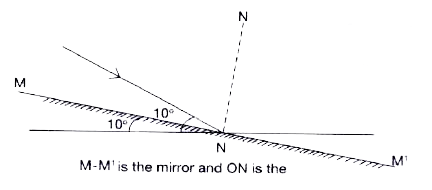Complete Solutions to Concept Application (Level 3) of chapter LIGHT of Class 8 book with complete answers and questions
| Class 8 | PHYSICS |
| Chapter | LIGHT |
| PEARSON IIT JEE FOUNDATION | Concept Application (Level 3) |
| Number Of Questions | 15 |
| Academic Year | 2023-24 |
A thin rectangular silver sheet acts as a plane mirror. A person who can see his face in it, holds it vertically, such that the length of the sheet is perpendicular to the ground. How does his image in the silver sheet change if the sheet is bent in a semi-circular way,
View SolutionObjects in the mirror are closer than they appear'. This statement is printed on the rear view mirrors of vehicles. What is its significance?
View SolutionThree plane mirrors are mounted on three walls forming an isosceles right triangle as shown in the figure. How many images are formed in all? Draw a diagram and indicate the positions of the images.

View SolutionIf v is the velocity of light in air or vacuum, find the time taken by the light to travel through a glass slab of thickness x and having refraction index `mu`.
View SolutionExplain how an opaque paper can be made translucent.
View SolutionA ray of light changes its wavelength from 6000 Å to 3000 Å, when it travels from one medium to another medium. What is the critical angle of the denser medium with respect to the rarer medium? [ Given sin 0 =0 , sin 30= `1/2` , sin 45 = `1/sqrt2` , sin 60 = `sqrt3/2`, sin 90=1 ]
View SolutionA ray of light PQ is incident on the face AB of an equilateral glass prism ABC as shown in the figure. Show that angle of emergence = angle of deviation. Also, with a ray diagram, trace the path of the emergent ray.

View SolutionThe face AC of the prism ABC of refracting angle `30^@` and refractive index square root 2 is silvered. A ray of light, after refraction from face AB, strike the face AC at `90^@`. Find the angle of incidence and path traced by the ray after reflecting from the silvered surface.
View SolutionAn object AB is placed on the principal axis of two lenses of equal focal length (f). The lenses are separated by a distance 2f, as shown in the figure. Using ray diagram locate the image formed by each lens and state their nature.

View SolutionAn object 10 cm tall is placed on the principal axis of a concave lens of focal length 10 cm at a distance of 15 cm from it. Find the position and nature of the image formed by the lens and draw the ray diagram.
View SolutionA ray of light making an angle `50^@` with the horizontal is incident on a plane mirror, which itself is inclined to the horizontal at an angle `10^@` as shown in the figure .Determine the angle made by the reflected ray with the horizontal _____

View SolutionAn object is placed in front of a convex mirror at a distance equal to the focal length of the mirror. If its focal length is 20 cm, the distance of the image from the mirror is ______ cm
View SolutionAn object is first placed at a distance of 24 cm from the lens and then at a distance of 16 cm from the lens. If the magnification of the image formed in both the cases is same, determine the focal length of the lens
View SolutionIn the spectrum of visible light which colour of light deviates the maximum?
View SolutionA convex mirror of radius of curvature 20 cm forms an image which is half the size of the object. Determine the position of the object from the pole of the mirror.
View Solution
Concept Application (Level 3) questions and complete solutions for chapter LIGHT of PEARSON IIT JEE FOUNDATION of Class 8
All Exercises from PEARSON IIT JEE FOUNDATION Class 8 PHYSICS LIGHT
- CLASSROOM CORNER (A. Very Short Answer Type Questions) ( Assertion - Reason Type - Questions)
- CLASSROOM CORNER (A. Very Short Answer Type Questions) ( Subjective Type Questions )
- CLASSROOM CORNER (A. Very Short Answer Type Questions) (Comprehension-Based Questions)
- CLASSROOM CORNER (A. Very Short Answer Type Questions) (Multiple Choice Questions)
- CLASSROOM CORNER (B. Short Answer Type Questions )
- CLASSROOM CORNER (C. Long Answer Type Questions )
- COMPETITION CORNER
- Concept Application (Level 1)
- Concept Application (Level 1) Fill in the blanks
- Concept Application (Level 1) Matching
- Concept Application (Level 1) True or False
- Concept Application (Level 2)
- Concept Application (Level 3)
- Example
- HOTS - HIGHER ORDER THINKING SKILLS
- SOLVED EXAMPLE
- Test Your Concepts (Essay Type Question)
- Test Your Concepts (Short Answer Type Question)
- Test Your Concepts (Very Short Answer Type Question)
- TRACK YOUR LEARNING - I
- TRACK YOUR LEARNING - II
- TRACK YOUR LEARNING - III
- TRACK YOUR LEARNING - IV